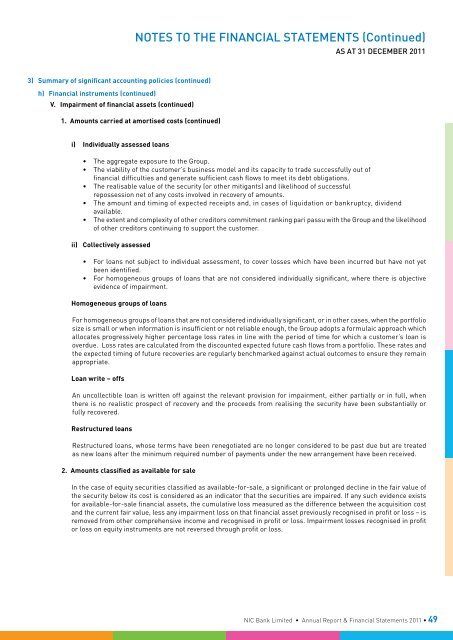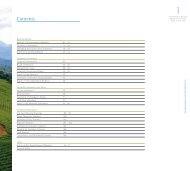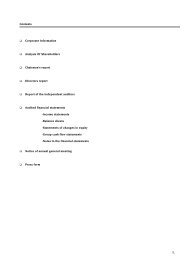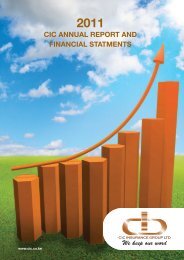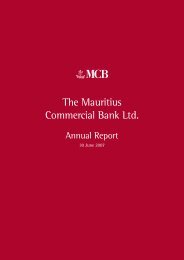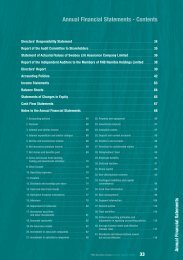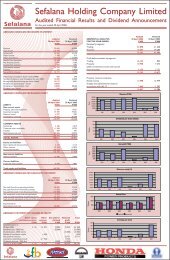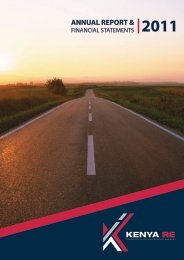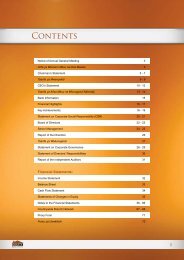Financial Statements 2011 - Investing In Africa
Financial Statements 2011 - Investing In Africa
Financial Statements 2011 - Investing In Africa
Create successful ePaper yourself
Turn your PDF publications into a flip-book with our unique Google optimized e-Paper software.
Notes To The <strong>Financial</strong> <strong>Statements</strong> (Continued)<br />
As at 31 december <strong>2011</strong><br />
3) Summary of significant accounting policies (continued)<br />
h) <strong>Financial</strong> instruments (continued)<br />
V. Impairment of financial assets (continued)<br />
1. Amounts carried at amortised costs (continued)<br />
i) <strong>In</strong>dividually assessed loans<br />
• The aggregate exposure to the Group.<br />
• The viability of the customer’s business model and its capacity to trade successfully out of<br />
financial difficulties and generate sufficient cash flows to meet its debt obligations.<br />
• The realisable value of the security (or other mitigants) and likelihood of successful<br />
repossession net of any costs involved in recovery of amounts.<br />
• The amount and timing of expected receipts and, in cases of liquidation or bankruptcy, dividend<br />
available.<br />
• The extent and complexity of other creditors commitment ranking pari passu with the Group and the likelihood<br />
of other creditors continuing to support the customer.<br />
ii) Collectively assessed<br />
• For loans not subject to individual assessment, to cover losses which have been incurred but have not yet<br />
been identified.<br />
• For homogeneous groups of loans that are not considered individually significant, where there is objective<br />
evidence of impairment.<br />
Homogeneous groups of loans<br />
For homogeneous groups of loans that are not considered individually significant, or in other cases, when the portfolio<br />
size is small or when information is insufficient or not reliable enough, the Group adopts a formulaic approach which<br />
allocates progressively higher percentage loss rates in line with the period of time for which a customer’s loan is<br />
overdue. Loss rates are calculated from the discounted expected future cash flows from a portfolio. These rates and<br />
the expected timing of future recoveries are regularly benchmarked against actual outcomes to ensure they remain<br />
appropriate.<br />
Loan write – offs<br />
An uncollectible loan is written off against the relevant provision for impairment, either partially or in full, when<br />
there is no realistic prospect of recovery and the proceeds from realising the security have been substantially or<br />
fully recovered.<br />
Restructured loans<br />
Restructured loans, whose terms have been renegotiated are no longer considered to be past due but are treated<br />
as new loans after the minimum required number of payments under the new arrangement have been received.<br />
2. Amounts classified as available for sale<br />
<strong>In</strong> the case of equity securities classified as available-for-sale, a significant or prolonged decline in the fair value of<br />
the security below its cost is considered as an indicator that the securities are impaired. If any such evidence exists<br />
for available-for-sale financial assets, the cumulative loss measured as the difference between the acquisition cost<br />
and the current fair value, less any impairment loss on that financial asset previously recognised in profit or loss – is<br />
removed from other comprehensive income and recognised in profit or loss. Impairment losses recognised in profit<br />
or loss on equity instruments are not reversed through profit or loss.<br />
NIC Bank Limited • Annual Report & <strong>Financial</strong> <strong>Statements</strong> <strong>2011</strong> • 49


